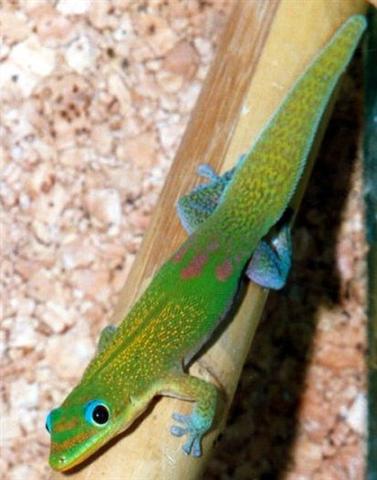5. We ought to have a picture of a lizard (moko) too:
A gecko is just as remarkable a creature as a flying fish, because he is capable of walking upside down in the night across the ceilings: "All geckos, excluding the Eublepharinae subfamily, have no eyelids and instead have a transparent membrane which they lick to clean. Many species will, in defense, expel a foul-smelling material and feces onto their aggressors. There are also many species that will drop their tails in defense, a process called autotomy. Many species are well known for their specialized toe pads that enable them to climb smooth and vertical surfaces, and even cross indoor ceilings with ease (one hypothesis explains the ability in terms of the van der Waals force). These antics are well-known to people who live in warm regions of the world, where several species of geckos make their home inside human habitations. These species (for example the House Gecko) become part of the indoor menagerie and are often welcome guests, as they feed on insects, including mosquitoes. Unlike most lizards, geckos are usually nocturnal and are great climbers." (Wikipedia) The ability to quickly travel in all dimensions with apparent ease is the common denominator for geckos and flying fishes. They can therefore represent the sons Moko respectively Maroro - if these months are located close to autumn equinox:
I.e., when Sun descends in atumn (or in the evening) he moves quickly from sky to earth and then down into the Underworld. One of the rare special comments Bishop Jaussen has given us relates to how moko goes down into the earth: "A une certaine saison, on amassait des vivres, on faissait fête. On emmaillottait un corail, pierre de defunt lézard, on l'enterrait, tanu. Cette cérémonie était un point de départ pour beaucoup d'affaires, notamment de vacances pour le chant des tablettes ou de la prière, tanu i te tau moko o tana pure, enterrer la pierre sépulcrale du lézard de sa prière." They buried (tanu) a wrapped piece of coral stone and it represented 'the dead lizard', te tau moko:
Te tau moko can be translated as 'the lizard stone' but I believe it is a 'word yoke' where the other meaning is 'the season of the lizard':
When they wrapped (emmaillottait) the coral stone it presumably was meant to illustrate that 'the lizard stone' no longer could be seen, no longer was present. Then, by burying te tau moko the reason for its disappearance became clear - the lizard had gone down into a hole (just as Sun). This, I guess, was the basic meaning of the custom. Possibly there was also an idea of the head of Sun being buried in the 'banana plantation', where Ure Honu later could find it with the help of a rat. Kiore is at left in Aa8-52. |





